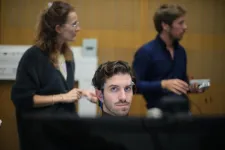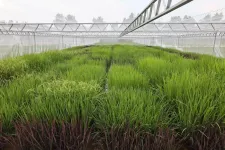(Press-News.org) LEUVEN October 31st - Alzheimer’s disease is characterized by a progressive loss of nerve cells leading to a decline in memory and cognition. A team of researchers at KU Leuven and VIB explored the molecular sequence of events in this cellular demise and identified specific inhibitors that could prevent the loss of nerve cells in different mouse models of the disease. The findings open up new research avenues in the search for therapies that could halt or prevent the accumulation of brain damage occurring in Alzheimer’s.
Alzheimer's disease, the leading cause of dementia, affects over 55 million people worldwide. The disease is characterized by the buildup of amyloid-beta plaques and tau protein tangles in the brain, which disrupt cell communication and lead to the widespread death of nerve cells. The consequences of this massive cell loss are the heartbreaking cognitive decline and memory loss for which the condition is well known.
Despite extensive research, for decades the only treatments available for Alzheimer’s offered temporary symptom management at best. Recently, however, the first drugs designed to target amyloid plaques have received (controversial) approval. While these new treatments successfully remove amyloid plaques, their clinical benefit in terms of improving cognition and memory has yet to be convincingly demonstrated. A conundrum underscoring once more the need to prevent nerve cell death to stop the cognitive impairment that affects Alzheimer’s patients.
In a new study published in Science Translational Medicine, a team of researchers led by Prof. Dietmar Thal, Prof. Bart De Strooper, and Dr. Sriram Balusu demonstrates they can indeed prevent loss of nerve cells in a mouse model of Alzheimer’s using specific inhibitors.
Necroptosis
“Nerve cells die in the context of Alzheimer’s disease as a consequence of a well-defined sequence of biochemical reactions, called ‘necroptosis’,” explains Balusu, postdoctoral researcher in the lab of De Strooper at the VIB-KU Leuven Center for Brain & Disease Research.
Last year, Balusu and his colleagues already announced they had mapped triggers for such necroptosis in human nerve cells transplanted into Alzheimer’s affected mouse brains.
To better understand the neurodegenerative process, and how it could be halted, the team now further explored the role of necroptosis in different mouse models for Alzheimer’s. They found that necroptosis was activated in mouse models with tau tangles but not in those that only exhibit amyloid plaques.
“Our results suggest that there exists a disease-related, delayed form of necroptosis, that is activated by a specific form of tau,” explains Thal, professor Neuropathology at KU Leuven.
Importantly, specific inhibitors intercepting activation of necroptosis not only prevent nerve cell loss, but also improve the social recognition memory of the mice.
De Strooper (VIB, KU Leuven, UK DRI): “Our findings indicate that necroptosis inhibition should be investigated further as a potential therapeutic strategy that could complement current amyloid and tau-directed therapies for treating Alzheimer’s disease.”
END
Can we protect nerve cells from dying?
Alzheimer researchers uncover protective pathway in mice
2024-10-30
ELSE PRESS RELEASES FROM THIS DATE:
Why does Lake Geneva emit large quantities of CO2? UNIL scientists provide the answer and solve a scientific enigma
2024-10-30
Unlike oceans, lakes are significant emitters of CO₂. But why is this the case, and what mechanisms are at play? For the first time, UNIL scientists have successfully explained the complete carbon cycle in Lake Geneva, creating a model that can be applied to several of the world's largest lakes.
Contrary to previous beliefs, it is the natural erosion of rocks that is responsible for the significant CO2 emissions from Lake Geneva and many of the world's large lakes.
This study provides the missing piece for understanding the carbon cycle in lakes.
The LéXPLORE lake platform in Switzerland played a major role in this discovery of international ...
Double strike against blood cancer
2024-10-30
Unseen and ongoing, thousands of times every second: to keep a complex organism like humans alive, an immense number of new cells must be continuously produced. Up close, each of these cell divisions is nothing short of a miracle. Within just a few hours, not only must the entire genome – billions of “letters” long – be replicated, but most other cellular structures must be doubled so that, in the end, two complete daughter cells can emerge.
Just before division, two complex protein structures, known as centrosomes, emerge, forming two opposing poles in the mother cell. These centrosomes grow long protein filaments, the spindle apparatus, ...
Combining VR and non-invasive brain stimulation: a neurotechnology that boosts spatial memory without surgery
2024-10-30
As we age, it becomes more difficult to remember where things are—whether it’s recalling where we left the keys or where we parked the car. This spatial memory deteriorates further with the onset of dementia, a condition that someone in the world develops every three seconds, according to Alzheimer’s Disease International.
Researchers at two EPFL labs have joined forces to give a boost to spatial memory by creating a unique experimental setup that combines non-invasive deep-brain stimulation, virtual reality training, and fMRI imaging—all housed within Campus Biotech in Geneva. Published in Science Advances, the study demonstrates that targeted, ...
A rudimentary quantum network link between Dutch cities
2024-10-30
An international research team led by QuTech has demonstrated a network connection between quantum processors over metropolitan distances. Their result marks a key advance from early research networks in the lab towards a future quantum internet. The team developed fully independently operating nodes and integrated these with deployed optical internet fibre, enabling a 25 km quantum link. The researchers published their findings in Science Advances.
The internet allows people to share information (bits) globally. A future quantum internet will enable sharing quantum information (qubits) over a new type of network. Such qubits ...
Accounting for bias in medical data helps prevent AI from amplifying racial disparity
2024-10-30
Black patients are less likely than white patients to receive medical tests that doctors use to diagnose severe disease, such as sepsis, researchers at the University of Michigan have shown.
Because of the bias, some sick Black patients are assumed to be healthy in data used to train AI, and the resulting models likely underestimate illness in Black patients. But that doesn't mean the data is unusable—the same group developed a way to correct for this bias in data sets used to train AI.
These new insights are reported in a pair of studies: one published ...
MD Anderson Research Highlights for October 30, 2024
2024-10-30
HOUSTON ― The University of Texas MD Anderson Cancer Center’s Research Highlights showcases the latest breakthroughs in cancer care, research and prevention. These advances are made possible through seamless collaboration between MD Anderson’s world-leading clinicians and scientists, bringing discoveries from the lab to the clinic and back.
Epigenetic targets and genomic stem cell pathways drive adult hair regeneration
Retrotransposons are interspersed repeating sequences that make up over 40% of the human genome. Proper tissue regeneration requires ...
Three Baycrest leaders named 2024 Canada’s Most Powerful Women: WXN’s Top 100 Award winners
2024-10-30
Toronto, ON, October 30, 2024 – Three Baycrest leaders are among those named winners of Women Executive Network’s (WXN) prestigious 2024 Canada’s Most Powerful Women: Top 100 Awards, celebrating exceptional leadership and groundbreaking achievements that have meaningfully transformed their industries, companies, communities and country.
Dr. Allison Sekuler, President and Chief Scientist, Baycrest Academy for Research and Education and President and Chief Scientist, Centre for Aging + Brain Health Innovation, powered by Baycrest (CABHI)
Dr. ...
Scientists uncover new mechanism in plant cold sensing
2024-10-30
Cold damage is a major challenge in rice production, and identifying key gene modules in signaling pathways is a crucial means of addressing this issue. A Chinese research team has recently discovered a part of the plant’s cell membrane that helps plants sense when it's cold.
This cell membrane component, known as the COLD6-OSM1 module, triggers the production of a special molecule, 2',3'-cAMP, which helps plants sense and respond to low temperatures. This secondary messenger is a key upstream component that mediates the signaling pathway by directly responding to signals ...
Study shows natural regrowth of tropical forests has immense potential to address environmental concerns
2024-10-30
A new study in Nature finds that up to 215 million hectares of land (an area larger than Mexico) in humid tropical regions around the world has the potential to naturally regrow. That much forest could store 23.4 gigatons of carbon over 30 years and also have a significant impact on concerns like biodiversity loss and water quality. The study showed that more than half of the area with strong potential for regrowth was in five countries: Brazil, Mexico, Indonesia, China, and Colombia.
“Tree planting in degraded landscapes can be costly. By leveraging natural regeneration techniques, nations can meet their ...
After a heart attack, the heart signals to the brain to increase sleep to promote healing
2024-10-30
A heart attack can trigger a desire to get more sleep, allowing the heart to heal and reduce inflammation—and this happens because the heart sends special signals to the brain, according to a new Mount Sinai study. This research is the first to demonstrate how the heart and brain communicate with each other through the immune system to promote sleep and recovery after a major cardiovascular event.
The novel findings, published October 30 in Nature, emphasize the importance of increased sleep after a heart attack, and suggest that sufficient sleep should be a focus of post-heart-attack clinical management ...
LAST 30 PRESS RELEASES:
Numbers in our sights affect how we perceive space
SIMJ announces global collaborative book project in commemoration of its 75th anniversary
Air pollution exposure and birth weight
Obstructive sleep apnea risk and mental health conditions among older adults
How talking slows eye movements behind the wheel
The Ceramic Society of Japan’s Oxoate Ceramics Research Association launches new international book project
Heart-brain connection: international study reveals the role of the vagus nerve in keeping the heart young
Researchers identify Rb1 as a predictive biomarker for a new therapeutic strategy in some breast cancers
Survey reveals ethical gaps slowing AI adoption in pediatric surgery
Stimulant ADHD medications work differently than thought
AI overestimates how smart people are, according to HSE economists
HSE researchers create genome-wide map of quadruplexes
Scientists boost cell "powerhouses" to burn more calories
Automatic label checking: The missing step in making reliable medical AI
Low daily alcohol intake linked to 50% heightened mouth cancer risk in India
American Meteorological Society announces Rick Spinrad as 2026 President-Elect
Biomass-based carbon capture spotlighted in newly released global climate webinar recording
Illuminating invisible nano pollutants: advanced bioimaging tracks the full journey of emerging nanoscale contaminants in living systems
How does age affect recovery from spinal cord injury?
Novel AI tool offers prognosis for patients with head and neck cancer
Fathers’ microplastic exposure tied to their children’s metabolic problems
Research validates laboratory model for studying high-grade serous ovarian cancer
SIR 2026 delivers transformative breakthroughs in minimally invasive medicine to improve patient care
Stem Cell Reports most downloaded papers of 2025 highlight the breadth and impact of stem cell research
Oxford-led study estimates NHS spends around 3% of its primary and secondary care budget on the health impacts of heat and cold in England
A researcher’s long quest leads to a smart composite breakthrough
Urban wild bees act as “microbial sensors” of city health.
New study finds where you live affects recovery after a hip fracture
Forecasting the impact of fully automated vehicle adoption on US road traffic injuries
Alcohol-related hospitalizations from 2016 to 2022
[Press-News.org] Can we protect nerve cells from dying?Alzheimer researchers uncover protective pathway in mice







